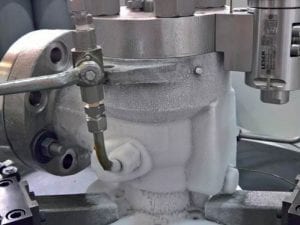Overpressure protection for LNG plants

The production of spring-loaded and pilot-operated safety valves for the LNG market takes experience and know-how. This article describes how one manufacturer has developed its own comprehensive test scenarios and also produced sealing surfaces that far exceed the tightness limits required by a leading standard.
At the time of writing, there is as yet no international standard for the cryogenic production testing for pilot-operated safety salves (POSVs). This is why LESER uses DIN EN 13648-1 as a basis and focuses the tests on the requirements of the market for cryogenic tests in production.
Furthermore, following a detailed analysis of the application several test scenarios were developed which indicate the relevance of POSVs for use in cryogenic applications. The overriding focus of these scenarios is to demonstrate the safe and reliable operation of the POSVs. These tests were carried out on the in-house low-temperature test bench at the company’s Hohenwestedt plant.
Three different scenarios were developed – M1, M2 and M3 – which realistically present the different operating states of the system to be protected.
In scenario M1, normal operation without POSV response is simulated to test the tightness under these cryogenic conditions. In the second scenario (M2), LESER checks the tightness and function of the POSV after opening the main valve under full load in the worst-case scenario. In addition, the use under arctic conditions is tested in scenario M3.
In the first scenario M1, the inlet is flushed with liquid nitrogen (-162°C) to cool the inlet area. After the cooling process, a setting pressure test and a leak test with helium as a test medium are carried out. The tightness test is therefore carried out under real conditions of -162 °C and a standard market pressure of 25 bar. The main valve of the POSV is closed, the ambient temperature is 24 °C.
In the second scenario M2, the POSV is also installed and the inlet is flushed with liquid nitrogen (-162 °C) to cool the inlet area. The main valve of the POSV is open to cool the outlet area of the main valve body. The ambient temperature is also 24 °C. This test represents a scenario with opening cycles of the main valve to reach the temperature in an emergency with LNG at -162 °C at the safety valve inlet and outlet of the open POSV in the event of a blow-off of the POSV. After the cooling process, a setting pressure test and a leak test with helium as a test medium are also carried out.
In scenario M3, the POSV is installed as in M1, and the main valve of the POSV is closed. To simulate an ambient temperature of -60 °C, the pilot is fully covered in dry ice. This results in a constant temperature of -162 °C at the main valve inlet and a constant temperature of -60 °C at the pilot valve inlet. After the cooling process, a set pressure test and a leak test with helium as a test medium are carried out. The conclusion of the test series is that the developed POSV design variant has successfully passed all tests for the challenging operating scenarios (see Figure 1) .

Fig 1: Test setup for cryogenic tests on spring-loaded safety valves.Precise machining – the prerequisite for tightness
The successful performance of a POSV can be directly linked to the nature and precision of the surface treatment. Since the sealing surfaces of seat and plate are most sensitive to reliable functionality, it is very important that a high quality of surface finish is guaranteed. With the LESER Nanotightness technology, a new manufacturing concept, the tightness requirements of API 527 are exceeded by 50 percent for all the company’s metal-seated safety valves. The result is achieved by a modified design and machining of seat and plate, which guarantees roughness and flatness values in the nanometer range.
The technology behind the Nanotightness concept focuses on surface quality, material handling and measurement technology. A multi-stage lapping, honing and polishing process ensures the required surface quality in the nanometer range. Surface protection and optimized handling processes are also guaranteed throughout the entire production process. And last but not least, optical measurement technology with nanometer accuracy provides meaningful results for process control (see Figure 2).

Fig 2: With LESER Nanotightness Technology, a new manufacturing concept, the tightness requirements of API 527 for gases are exceeded by 50 percent.LNG: an important alternative energy source
Energy demand is rising worldwide. This makes liquefied natural gas (LNG) an important alternative to conventional energy sources. LNG can be produced by strong compression or cooling to -161 to -164 °C. And since it contains only about one six-hundredth of the volume of gaseous natural gas, it offers many advantages in terms of transport and storage.
It’s a fact: Global trade in LNG reached a volume of 38.2 billion cubic feet per day (around 1.08 billion cubic meters per day) in 2017, according to the US Energy Agency (EIA). Compared to the previous year, this corresponds to a growth of ten percent. This makes LNG demand the fastest growing of all available energy sources.

API 526

General design of the LESER Pilot Operated Safety Valve. All images courtesy of LESER
To find out more about our LESER Safety Valve product line please go to our LESER Brand page or call us at (403) 252-8803.
About the Author
Andreas Caldonazzi graduated in 1997 from the Technical University of Hannover, Mechanical Engineering Faculty. Upon joining LESER GmbH & Co. KG he spent six years in the technical department. In 2009 he was appointed Product Manager of the newly developed product group High Efficiency with Pilot Operated Safety Valves and Safety Valves with Supplementary Loading System.
Today he is also involved in new development strategies and second-level technical support (expert level) for sizing of safety valves and the product group High Efficiency.
Download PDF – Overpressure protection for LNG plants.
